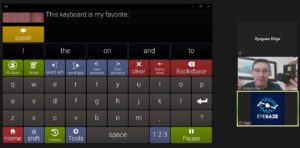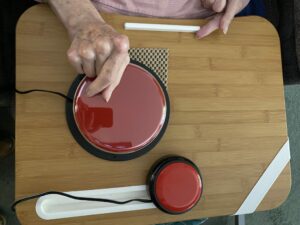Our objective: Find out 1. Is the eye trackable? 2. How accurate a calibration can they obtain? 3. After calibration, can they access needed pages for communication and computer control?
Details: Diagnosis is Cortical Basal Degeneration. Per spouse, this patient is losing their voice, and has no function in Right arm/hand. They have some residual function in the Left arm/hand. This patient is currently working with an SLP and a neurologist.They have next to no mobility in the Right arm, very limited in the Left arm. Patient has an iPhone, but finds it very difficult to navigate with their fine motor deficits. Using voice to text, but speech is impaired characterized by low vocal volume and dysarthria. Patient tried (name removed) device unsuccessfully, and also did not like the (name removed) device. Eye history: bilateral cataract removal, toric lenses. Prism single-vision glasses (computer distance). Uses eye drops regularly due to dry eyes. Diagnosed with ptosis (most noticeable on the Left eye).
Eyegaze Edge trial: Demo was planned to be remote due to this patient’s location. We initially attempted calibration with the Eyegaze Encore camera tracking both eyes, without artificial lens accommodation turned on. Because they appeared to have more ptosis on the Left eye, we changed the settings to track Right eye only, and switched on artificial lens accommodation, as well as the Eyegaze simple, 5-point calibration setting. Despite these accommodations, and the ability to get through 5 out of 5 points, their calibration number was high, indicating poor calibration. Out of curiosity, we took them to the heat mapping page in Mind Express, and while the bottom of the screen seems to have been problematic (especially the lower corners), the top 2/3 of the screen seemed to be tracking them ok.
Calling in the experts: The Eyegaze Inc. technical joined us to assist, and we played with the calibration points a bit (clustering all 5 points towards the center of the screen), and switched to the Prime camera (which we tried on the Right eye, and then tried on the Left eye) with similar results: all of the red + indicators were clustered together.

An Eyegaze Remote Demonstration Setup
Researching cortical basal degeneration AND prism lenses: This from NIH: “Typical ocular features include increased latency of saccadic eye movements ipsilateral to the side exhibiting apraxia, impaired smooth pursuit movements and visuo-spatial dysfunction, especially involving spatial rather than object-based tasks.” After a second trial, it was determined that eye tracking with difficulty slowed oculomotor movement and prism glasses was not a viable option. attempts to calibrate and use a QWERTY keyboard were not accurate.
What else can we try that will work? Having ruled out eye tracking across

Jellybean switch combined with a Headmouse Nano
various eye trackers, we pulled out our Headmouse Nano, and the patient demonstrated good head/neck range of motion, with no complaints of pain, soreness, or stiffness. Eyegaze sent a HeadMouse Nano with button switch, and the patient was able to dwell to target, and switch to select! They demonstrated accurate selection of buttons to type on QWERTY keyboard, navigate Eyeworld, scroll web page and select links (using Links flag selections).
This type of remote demonstration (and success!) was made possible by providing multiple access methods to trial, collecting a detailed case history, and relying on multiple individuals to suggest ideas and provide support. These were not brought into the conversation until Eyegaze Inc. was called in to provide a demonstration, and we are now offering our resources to this clinic for future patients!
